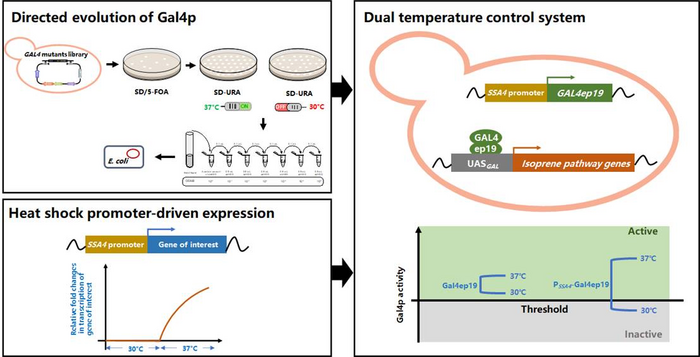The Baker’s yeast, Saccharomyces cerevisiae, has been extensively engineered to produce a vast variety of chemicals that are not naturally produced by yeast, including the important monomer for synthetic rubber, isoprene. However, all organisms are naturally evolved for better survival rather than maximized biosynthesis of products of human interest. S. cerevisiae is not an exception. Impaired cell growth was observed during its engineering by pathway compartmentation for improved isoprene biosynthesis. To address this issue, researchers from the College of Chemical and Biological Engineering of Zhejiang University have developed a temperature-responsive dynamic control system to regulate the initiation time of isoprene biosynthesis during the fermentation. This study was published online in Frontiers of Chemical Science and Engineering on 15 July 2022.

Credit: Jiaxi Lin
The Baker’s yeast, Saccharomyces cerevisiae, has been extensively engineered to produce a vast variety of chemicals that are not naturally produced by yeast, including the important monomer for synthetic rubber, isoprene. However, all organisms are naturally evolved for better survival rather than maximized biosynthesis of products of human interest. S. cerevisiae is not an exception. Impaired cell growth was observed during its engineering by pathway compartmentation for improved isoprene biosynthesis. To address this issue, researchers from the College of Chemical and Biological Engineering of Zhejiang University have developed a temperature-responsive dynamic control system to regulate the initiation time of isoprene biosynthesis during the fermentation. This study was published online in Frontiers of Chemical Science and Engineering on 15 July 2022.
The native transcriptional activator Gal4p of S. cerevisiae was engineered to gain temperature sensitivity and meanwhile its expression was driven by a heat-shock promoter. In this way, a dual temperature regulation system was developed, the application of which led to limited expression of pathway genes at the optimal temperature for cell growth (30 °C) and enhanced gene expression when the culture temperature was switched to the optimal temperature for isoprene synthesis (37 °C).
The “cold-sensitive” Gal4p mutant playing the key regulatory role was created by the Nobel prize-winning directed evolution technology. To facilitate fast and accurate selection of the mutants with temperature sensitivity from the random mutant library containing thousands of mutants, a growth-indicated high-throughput screening method was established based on the cytotoxicity of 5-fluorouridine formed by URA3-catalyzed conversion of 5-fluoro-orotic acid. The negative correlation between Gal4p activity at a certain temperature and the biomass of 5-fluorouridine-accumulating strains enabled selection of Gal4p mutants with lower activity at 30 °C and higher activity at 37 °C.
When the “cold-sensitive” Gal4p mutant was expressed under the control of a heat-shock promoter, its regulatory activity at the permissive temperature was further increased due to the enhanced expression level, and the basal expression of the pathway genes at the restrictive temperature was further reduced. Employment of this dual temperature control strategy led to 34.5% and 72% improvements in cell growth and isoprene production of S. cerevisiae, respectively. This study reports the creation of the first cold-sensitive variants of Gal4p by directed evolution and provides a dual temperature control system for yeast engineering that may also be conducive to the biosynthesis of other high-value natural products.
###
Reference: Jiaxi Lin et al. (2022). Development of a dual temperature control system for isoprene biosynthesis in Saccharomyces cerevisiae, Frontiers of Chemical Science and Engineering DOI: 10.1007/s11705-021-2088-0
About Higher Education Press
Founded in May 1954, Higher Education Press Limited Company (HEP), affiliated with the Ministry of Education, is one of the earliest institutions committed to educational publishing after the establishment of P. R. China in 1949. After striving for six decades, HEP has developed into a major comprehensive publisher, with products in various forms and at different levels. Both for import and export, HEP has been striving to fill in the gap of domestic and foreign markets and meet the demand of global customers by collaborating with more than 200 partners throughout the world and selling products and services in 32 languages globally. Now, HEP ranks among China’s top publishers in terms of copyright export volume and the world’s top 50 largest publishing enterprises in terms of comprehensive strength.
The Frontiers Journals series published by HEP includes 28 English academic journals, covering the largest academic fields in China at present. Among the series, 13 have been indexed by SCI, 6 by EI, 2 by MEDLINE, 1 by A&HCI. HEP’s academic monographs have won about 300 different kinds of publishing funds and awards both at home and abroad.
About Frontiers of Chemical Science and Engineering
Frontiers of Chemical Science and Engineering presents the latest developments in chemical science and engineering, emphasizing emerging and multidisciplinary fields and international trends in research and development. The journal promotes communication and exchange between scientists all over the world. The contents include original reviews, research papers and short communications. Coverage includes catalysis and reaction engineering, clean energy, functional material, nanotechnology and nanoscience, biomaterials and biotechnology, particle technology and multiphase processing, separation science and technology, sustainable technologies and green processing. The Editors-in-Chief are Academician Jingkang Wang from Tianjin University, Academician Qunji Xue from Ningbo Institute of Industrial Technology and Academician Jiongtian Liu from Zhengzhou University. The journal has been indexed by SCI, Ei, CA, ChemWeb, INSPEC, SCOPUS, Source Journals for Chinese Scientific and Technical Papers and Citations, CSCD, etc.
Journal
Frontiers of Chemical Science and Engineering
DOI
10.1007/s11705-021-2088-0
Method of Research
Experimental study
Subject of Research
Cells
Article Title
Development of a dual temperature control system for isoprene biosynthesis in Saccharomyces cerevisiae
Article Publication Date
15-Jul-2022




